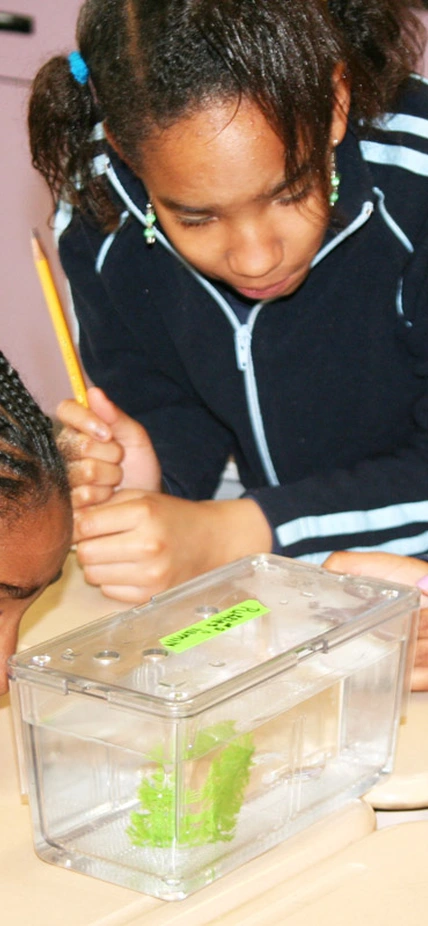Baltimore, MD—A first-of-its-kind study on almost 20,000 K-12 underrepresented public school students shows that Project BioEYES, based at Carnegie’s Department of Embryology, is effective at increasing students’ science knowledge and positive attitudes about science. Younger students had the greatest attitude changes. The study covered five years and tested students before and after the one-week BioEYES program. The research is published in the November 10, 2016, issue of PLOS Biology.
BioEYES (www.bioeyes.org) uses live zebrafish to teach basic scientific principles, animal development, and genetics. The zebrafish embryo is clear, making it ideal for observations. Each BioEYES Center reflects a partnership between local educators, school districts, and cutting-edge scientific laboratories like that of Steve Farber, co-founder of the program.See video.
This collaboration empowers the students to approach science just as a professional scientist would. The program provides scientific equipment and teaches concepts that are relevant to students’ lives. In this case, inner-city students learn about the inheritance of skin color from a biological perspective.
Over the course of a week, students collect zebrafish embryos and watch them develop from a single cell to a swimming larva complete with a beating heart and a distinct pigmentation pattern. Elementary students learn about human and fish anatomy, habitats, cells, and DNA. Older students identify the observable traits of their zebrafish offspring (middle school) or delve into the ways modern scientists determine the genetic makeup of parents by studying their offspring (high school). At week’s end, students analyze these data and discuss their results with their fellow students, much the way real scientists do.
For the five-year study (2010-2015) reported in PLOS Biology, the BioEYES team assessed students and teachers before and after a weeklong experiment. They asked students to answer knowledge-based questions as well as questions about their attitudes toward science and scientific careers. Following a BioEYES experience, all grade levels showed significant positive gains in learning. Seven of the eight knowledge questions had significant positive gains for elementary students. At the middle school level, eight of the nine knowledge questions had significant positive gains. Some middle school questions that showed the greatest gains involved concepts in genetics with changes from 72 - 87% depending on the question. The high school questions with the greatest gains were about characteristics of model organisms with a 64% change and stem cells with a 56% change.
Interestingly, for all grade levels BioEYES increased students’ ability to imagine themselves as scientists. The largest effect on attitudes occurred at the elementary school level—six out of eleven statements showed significant positive changes. Among all grade levels, the strongest attitude shift was in the statement, “I know what it’s like to be a scientist.”
The second largest attitude change observed in elementary and high school grades, and the third largest in middle school, was an increase in agreement with the statement, “Science is becoming more popular than it used to be.”
Co-founder Farber remarked, “We think educators can leverage this finding in a big way. We think this result shows that BioEYES was fun and engaging for everyone in the class. We know how important popularity is to the social lives of kids. So if the science experience is fun, engaging, and popular, more underserved students could be attracted to the Science, Technology, Engineering, and Math (STEM) fields.”
Farber started BioEYES with educator Jamie Shuda at the University of Pennsylvania and brought BioEYES to Carnegie in 2007. Some 100,000 students have participated in the outreach effort. Additionally, some 1,300 teachers in six states and two countries (the U.S. and Australia) have been trained to teach the course.
“It turns out that our efforts in training teachers have made a huge impact,” Farber said. “We see that the program increases their confidence to create innovative and engaging science lessons, which affects many more students beyond BioEYES. Using BioEYES to reach a large population of underserved students can help spark their interest in research and hopefully encourage them to explore college and other STEM career options. While much of time I am exploring questions relating to how cells process fats and related molecules, I feel immensely lucky to have created a program that has reached so many and to be part of an institution like Carnegie that takes seriously its role in inspiring the next generation of STEM leaders.”
--------------
BioEYES is a joint effort between the Carnegie Institution for Science and the Johns Hopkins University School of Education. Additional centers are located at the University of Pennsylvania, the University of Utah, and Monash University in Melbourne, Australia. The program is funded by grants and gifts with help from the Carnegie Institution’s endowment. A complete list of sponsors can be found at the project’s website http://www.bioeyes.org/index.php
